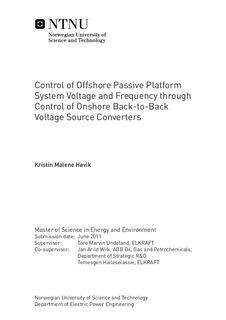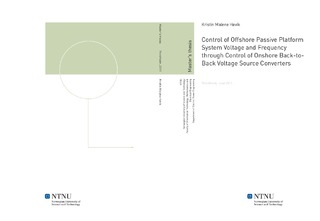| dc.description.abstract | This thesis work shows implementation and testing of existing control strategies in a novel offshore passive platform configuration. Control of the platform voltage and frequency is done through control of a shore-based B2B-VSC configuration, when the frequency on shore differs from the frequency on the platform. An 80 km HVAC-cable and transformers separates the shore-based B2B-VSCs from the platform installation. The system is modeled and simulated in MATLAB® Simulink SimPowerSystems . The grid-side VSC is applied conventional cascaded controllers, with an inner current control loop and outer loops controlling the DC-link voltage and the flow of reactive power from the grid. Two different control strategies were implemented for the platform-side VSC, denoted as control strategy 1 and 2. Control strategy 1 controls the platform voltage magnitude, while keeping the frequency fixed, and is implemented with a simple PI-controller. Control strategy 2 controls both platform voltage magnitude and frequency, and was based on a cascaded control configuration, similar to that of a weak-grid system, implemented for the passive platform system. Both control strategies were implemented for the platform system and tested for three worst-case changes of platform load: loss of all loads, increase of passive load and large induction motor starting. The platform steady-state and transient voltages and frequency were evaluated based on the requirements for voltage and frequency defined in IEC 61892: standard for mobile and fixed offshore units, electrical installations. Control strategy 1 was tested for both normal and autonomous operation, when a constant DC-link voltage was applied. It was also tested for full B2B-VSC configuration, with the grid-side system VSC controlling the DC-link voltage and flow of reactive current from the grid. In all the three configurations, control strategy 1 failed to meet the system requirements set by the IEC 61892 standard for allowable voltage magnitude transients during loss-of-all-load and large-induction-motor-start. Control strategy 2 was tested with constant DC-link voltage when platform voltage measurements were available. The simulation results show no visible voltage or frequency transients for any of the three load change tests applied, and the system operation satisfies the IEC 61892 requirements for all the worst-case load change tests. The platform voltage and frequency are independent of the load dynamics, which is a desirable quality when controlling the voltage on a complex platform configuration. Control strategy 2 shows promising potential for controlling the platform voltage and frequency from shore. However, further research and testing must be done before this control strategy can be utilized in a real platform system. The proposed system controlled by control strategy 2 would allow removal of the low efficiency, high emission gas turbine driven synchronous generator that are the standard power source on oil platforms today. Eliminating the need for, or usage of the gas turbine, for power production on offshore oil and gas platforms, could reduce the total CO2 and NOx emissions of the petroleum sector considerably. | nb_NO |

